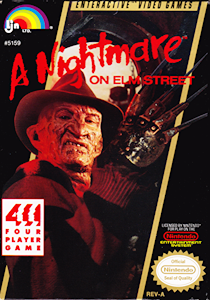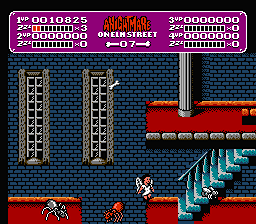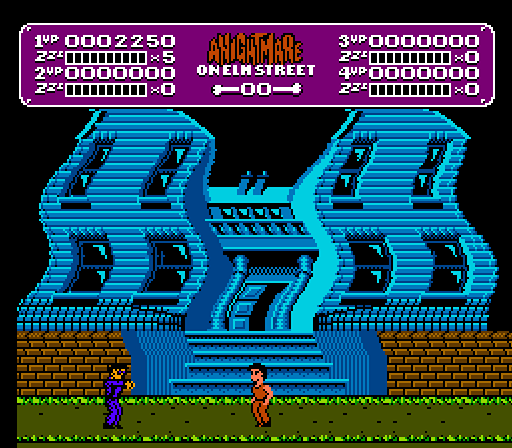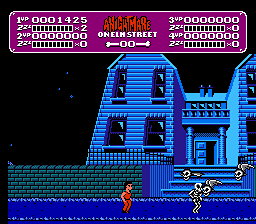
A Nightmare on Elm Street (1990-)
Developer: Rare
Publisher: LJN
Genre: Platform
A Nightmare on Elm Street for the NES was developed by Rare and released in 1990, with LJN serving as the publisher. The game was created during a period when licensed horror titles were becoming increasingly popular, drawing directly from the A Nightmare on Elm Street film series and its iconic antagonist, Freddy Krueger. Although it was based on the larger movie franchise, it did not have a video-game prequel, nor did it receive ports to other consoles. The developers aimed to capture the tone of the films while adapting the concept into a format suitable for an action-focused NES title.
The game’s premise centers on players controlling a teenage protagonist who must collect Freddy’s scattered bones and ultimately destroy him. Players move through various Elm Street locations inspired by scenes and ideas from the films, including houses, junkyards, and boiler rooms. One of the game’s defining inspirations is the tension between the real world and the dream world, a core theme from the movies, which Rare incorporated into a gameplay mechanic that forces the player to stay awake or risk entering a more dangerous dream state.
Gameplay features include side-scrolling action, platforming, and a character progression system tied to dream-world transformations. When the player falls asleep, their abilities change, granting access to new attacks but also introducing tougher enemies and faster danger. Up to four players could play simultaneously with the use of the NES Four Score accessory, a notable feature for the time. Boss fights with Freddy in various forms punctuate the level progression, each requiring pattern recognition and careful timing. The soundtrack uses tense, atmospheric compositions and sharp sound effects to reinforce the game’s horror theme, blending music with cues meant to alert the player to shifts between the real and dream worlds.
A Nightmare on Elm Street did not receive any sequels on the NES, nor did its storyline continue in later official game adaptations of the film series. Promotion focused on its connection to the popular movie franchise, with advertisements in gaming magazines highlighting the licensed horror setting and four-player capabilities. Reception at the time was mixed; some reviewers praised its creativity, cooperative features, and attempt to translate the film’s ideas into gameplay, while others felt its difficulty spikes and structure were uneven. Despite these responses, it remains one of the more distinctive licensed horror titles released for the NES.
Images from MobyGames
Buy A Nightmare on Elm Street
Click one of the Ebay or Amazon buttons below to check the latest prices and purchase A Nightmare on Elm Street for the Nintendo Entertainment System.

Related Searches
A Nightmare on Elm Street NES Download
A Nightmare on Elm Street is available to purchase and download from a range of vendors. Always shop around...
A Nightmare on Elm Street NES Manual
Various repositories around the internet have scanned and archived a range of retro manuals. Search now to.....
A Nightmare on Elm Street NES Rom
We don't host or link to rom sites for this game. However, there are many sites out there that may be...
A Nightmare on Elm Street NES Walkthrough
Many sites - particularly YouTube - host a range of walkthrough videos to guide you in your quest to get...
A Nightmare on Elm Street NES Cheats
There are various sites out there that can offer cheat codes for games. Search now to find all available...
A Nightmare on Elm Street NES Controls
This information can often be obtained through the user manual. Alternatively there are many sites out there...
A Nightmare on Elm Street NES Release Date
The initial release date for A Nightmare on Elm Street is stated as October 1990. Other ports of the game may..
A Nightmare on Elm Street NES Review
There are many sites out there that have collated and documented historic reviews of this game. Search now...
A Nightmare on Elm Street Famicom
As a Nintendo Entertainment System release, this game was also likely also available on the Famicom. This....
A Nightmare on Elm Street NES Speedrun
There is now a community of competitive speedrunners who will try and gain the fastest possible time on their....








